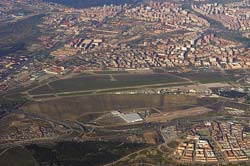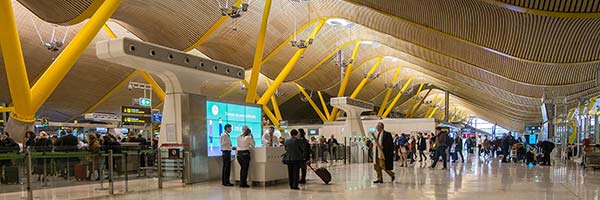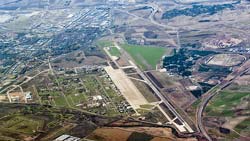Madrid Airports
 The first airfield in Spain was in Madrid. It opened in 1911 and was situated 8km SW of the city centre. It was named "Cuatro-Vientos" (Four Winds) and still carries that name to this day. It was originally a military field and has remained so, although part of it is now used for civil aircraft. Because its runways are relatively short (one is still grass!) it is mainly used by flying schools and helicopters.
The first airfield in Spain was in Madrid. It opened in 1911 and was situated 8km SW of the city centre. It was named "Cuatro-Vientos" (Four Winds) and still carries that name to this day. It was originally a military field and has remained so, although part of it is now used for civil aircraft. Because its runways are relatively short (one is still grass!) it is mainly used by flying schools and helicopters.
In 1919 James Peters was the first person to fly non-stop from London to Madrid, a flight lasting 9 hours. He carried a letter for the Queen of Spain from Mr. Gillow, who had built the plane. On his return to England, Peters named his house "Cuatro-Vientos".
In recent years the airfield has been used as the venue for Papal Masses. The Museo del Aire, an air and space museum mainly dedicated to the Spanish Air Force, is located on the southern side of the airport.
Madrid’s second airport opened in 1931 and was called Madrid-Barajas Airport. It had a small terminal building designed to deal with 30,000 passengers a year. (It is currently at about 60 million). The first commercial flights began in 1931 when Lineas Aéreas Postales Españolas began flights to Barcelona. Originally the airfield was a large field, covered in grass and had "Madrid" painted in white in the middle of it. It was not until the 1940’s that it gained concrete runways.
By the end of the decade, it had three runways (none of which exist now) and the airport began operating flights to Latin America and the Philippines. Since then the airport has grown considerably. In terms of area it is the second largest in Europe (after Paris, Charles de Gaulle) and the 6th busiest.
The main runway is the 4th longest in Europe and 26th in the world.It has five terminals, one of which is used for flights within the Schengen area. Terminal 4 is one of the world’s largest terminals at 760,000 square meters (8,180,572 square ft). It has been designed to give passengers a stress-free start to their journey.

Over the course of a year, approximately 80 airlines operate 193 routes out of Barajas. (A high proportion of which are to Latin America.) The busiest route is the one to Barcelona known as the "Puente Aéreo" (Air Bridge). It is the busiest route between two European airports. In 2012 there were 55 daily flights, however the opening of the high-speed rail line has reduced the frequency.
During the last week of September 2019 there were 4,104 departures to 201 different airports in 71 countries. One hundred and ninety-five of those departures were to Barcelona. Currently Barajas is at 23 in a list of the busiest airports in the world. It is climbing back up the list having slipped from 10th in 2007.
Following the death of former Spanish Prime Minister, Adolfo Suárez, in 2014, the Spanish Ministry of Public Works and Transport announced that the airport would be renamed Aeropuerto Adolfo Suárez, Madrid-Barajas. This renaming seeks recognition for Suárez’s role as the first Prime Minister of Spain after the restoration of democracy and his key participation in the transition to democracy after the dictatorship of Francisco Franco.
 There is a third airport in Madrid - Madrid-Torrejón Airport. It began life in 1942 as the Spanish Institute of Aeronautics (Instituto Nacional de Técnica Aeronáutica).In those days it had a grass runway 1,300 metres (4,266ft) in length but the 1953 Pact of Madrid gave the USA bases in Spain and work began to convert the airfield into the US Air Force Torrejón Base.
There is a third airport in Madrid - Madrid-Torrejón Airport. It began life in 1942 as the Spanish Institute of Aeronautics (Instituto Nacional de Técnica Aeronáutica).In those days it had a grass runway 1,300 metres (4,266ft) in length but the 1953 Pact of Madrid gave the USA bases in Spain and work began to convert the airfield into the US Air Force Torrejón Base.
The runway was concreted and lengthened to 4,084 metres (13,400ft). For the next 30 years it would be the longest runway in Europe, it has since been extended further to 4,818m (15,807ft) but is now only the 3rd longest. (And 9th in the world).
The base became operational in 1957 and continued to be so until 1987 when the agreement came up for renegotiation. As part of its NATO obligations, Spain had to rely less on the USA presence and after some acrimonious discussions a timetable for withdrawal was drawn up, the US would withdraw before mid-1991.
Fate took a hand though, the 1990-91 Kuwait crisis delayed the withdrawal until 21st May 1992. The military side of the base reverted to Spanish control. Amongst the many units based there are the Royal and VIP flights and the electronic warfare unit. It is also the base of the European Union’s Satellite Centre (EUSC).
In the mid-90s the base became dual military and civilian use and handles charter and executive traffic. It is also used to reduce overcrowding at Barajas.

